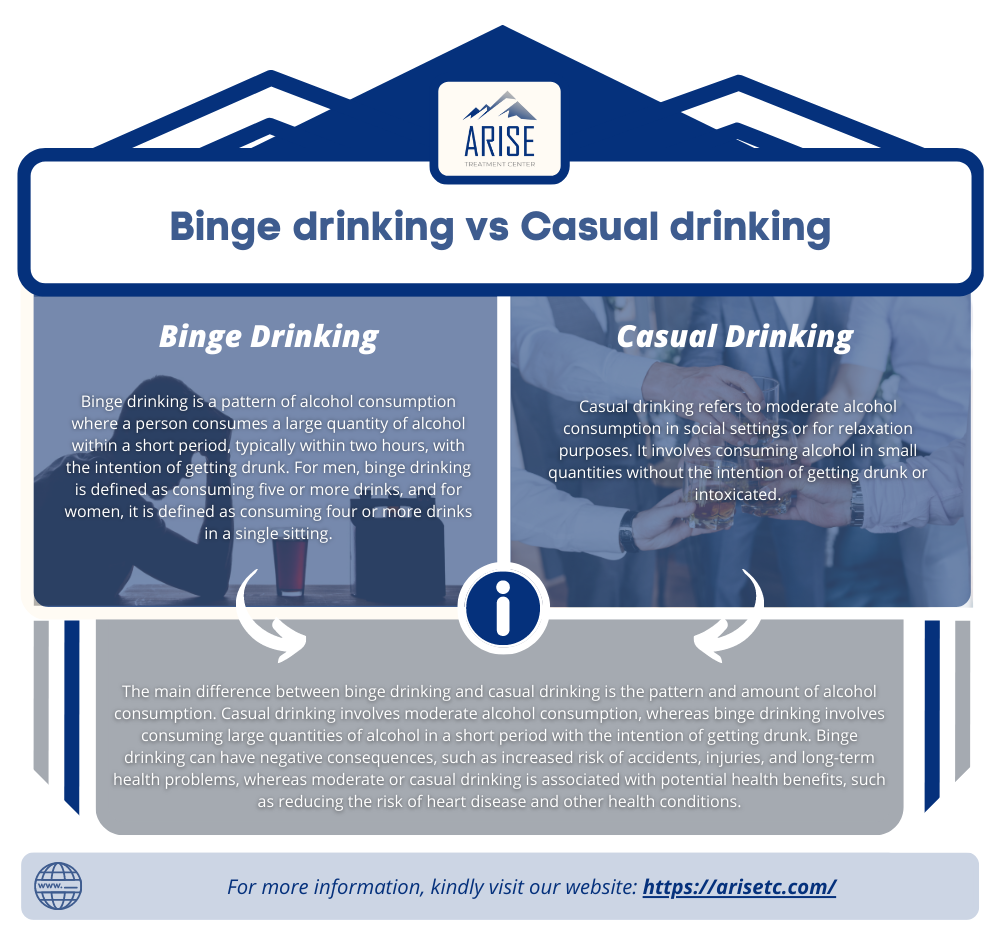Most adults in the United States drink alcohol from time to time. Drinking is part of the country’s culture, and alcohol is accepted as a normal part of many social functions.
But how do you know if your drinking has crossed a line and become problematic? Understanding the differences between binge drinking, social drinking, and casual drinking can help you identify a problem and seek treatment, if necessary.
Reach out to the caring team of specialists at Arise Treatment Center to explore your treatment options or find support during addiction recovery.

How Much Alcohol is Too Much?
The Centers for Disease Control (CDC) offer guidelines about alcohol consumption and how it can impact your health. The CDC recommends that if you choose to consume alcohol, you do so in moderation. But what does this mean, exactly?
According to the CDC, moderate drinking means:
- Having one or fewer alcoholic drinks per day for women
- Having two or fewer alcoholic drinks per day for men
A “drink” is defined as:
- 12 ounces of beer
- 5 ounces of wine
- 1.5 ounces of distilled spirits like vodka, rum, and whiskey
- 8 ounces of malt liquor
Many standard drinks you’d get at a bar or restaurant may count as more than one “drink,” as defined by the CDC. It’s important to understand and track how much alcohol you are actually consuming if you do choose to drink.
Moderate drinking is not linked to known short or long-term health complications. However, drinking moderately might be a problem for people with certain medical conditions, including people taking certain medications, pregnant people, and those with a history of addiction. Talk to your medical provider about whether it is safe for you to drink in moderation.
What is Binge Drinking?
Binge drinking is a pattern of drinking that causes the level of alcohol in your blood (blood alcohol concentration, or BAC) to be 0.08% or higher. This often occurs when you drink a large amount of alcohol in a short period.
For women, binge drinking means having four or more alcoholic drinks in a short period–about 2 hours. For men, it means consuming about five alcoholic beverages in the same period.
Binge drinking is relatively common in the United States. In recent research, about 60 million people over the age of 12 reported binge drinking in the previous month. Young adults’ levels of binge drinking are high, with around 27% reporting at least one episode of binge drinking in the last month.
Older adults make up a smaller percentage of binge drinking–11.4% reporting binge drinking in the previous month–but numbers are rising. Many medications older adults take to manage chronic health conditions can have dangerous interactions with alcohol, which concerns medical health experts.
Women are more likely to report binge drinking, with about 25% of women in all age categories admitting to binge drinking in the previous month.
Binge drinking is linked to many short and long-term health consequences, including:
- Sexually transmitted diseases
- Accidents, including car crashes, burns, drowning, and falls
- Pancreatitis
- Liver disease
- Kidney disease
- Cancers of the head, neck, esophagus, breast, stomach, and colon
Binge drinking can be hazardous in the short term and lead to severe, sometimes life-threatening harm to your health.
What is Casual Drinking?
Casual drinking is a pattern of alcohol consumption that does not pose the risk of danger or long-term harm to your health. People who drink casually–sometimes called social drinkers–may only drink on rare occasions. Social drinkers do not drink more than they plan to and do not engage in risky behaviors while drinking. They may only drink once or twice a week or a few times monthly.
Casual drinkers do not attempt to get drunk when they consume alcohol. They always find a sober ride home if they drink too much alcohol, and they know when it’s time to stop drinking.
Social Drinking: Is it a Problem?
Social drinking, or casual drinking, is not usually a problem. People who drink casually are in control of their drinking and do not lose their judgment while drinking.
However, people who only drink casually may have much lower alcohol tolerance than people who engage in binge drinking or drink heavily. This means if they consume more alcohol than they are used to, they may become more intoxicated.
If casual drinkers are not used to getting drunk, they may exhibit poor judgment and engage in risky behaviors, even if their alcohol consumption doesn’t meet the standard for binge drinking.
Do I Need Alcohol Abuse Treatment?
Since alcohol use is common and widely accepted in our culture, it can be challenging to identify alcohol abuse. Here are some of the signs that your relationship with alcohol has become unhealthy or problematic:
- You frequently drink more than you intended to
- You have blackouts
- You engage in risky behavior, such as driving or having sex, while intoxicated
- You have health problems related to your drinking
- You cause or are involved in an accident or injury while intoxicated
- You can’t keep up with your responsibilities at home, work, or school because of drinking
- You have withdrawal symptoms when you stop drinking
These and other signs of problematic drinking may indicate that you need treatment and support to regain control over your alcohol consumption. Don’t wait until you face severe consequences of alcohol abuse. Get help as soon as you identify a problem.
Find Help Now
Reach out to the team at Arise Treatment Center to learn more about our holistic, supportive approach to alcoholism treatment. You don’t have to live with the life addiction chooses for you. Effective, compassionate treatment that can help you live the life you choose is just a phone call away. Call today.

